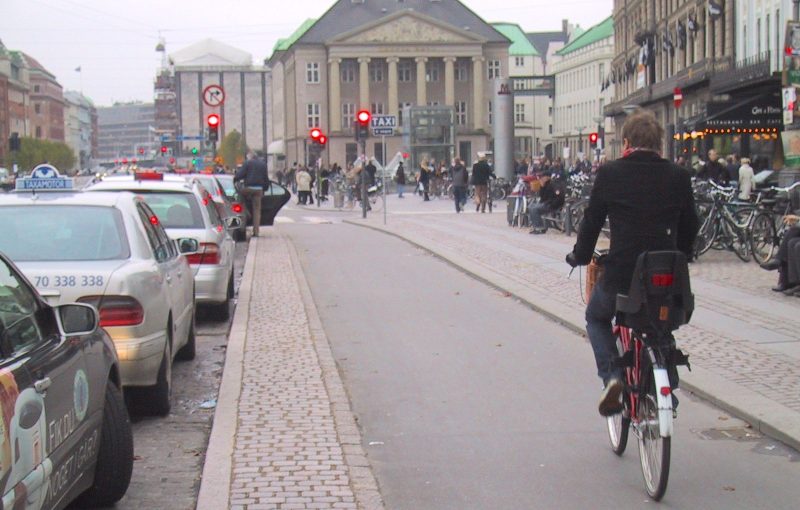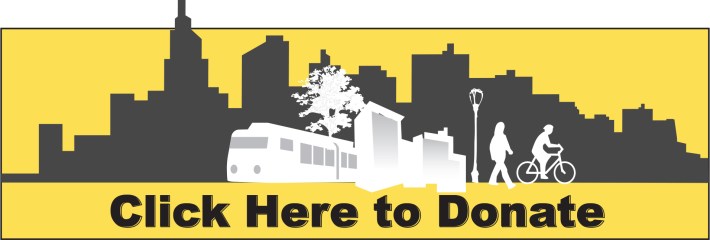A BILL OF GOODS: Why are We Putting Up With <i>Parking</i>-Protected Bike Lanes?
3:06 PM EST on December 3, 2019

Copenhagen: This is a real bike lane because it doesn’t need cars for protection.

Europe is literally laughing at us.
The rest of Western Civilization has managed to build tens of thousands of kilometers — we call them miles — of protected bike lanes by removing a form of infrastructure that caters entirely to cars: parking.
Yes, it's time to examine the parking-protected bike lane — a one-lane bike path adjacent to a row of stored cars. Good luck stumbling upon one of those in Amsterdam or Copenhagen. European cyclists are free to ride without the threat of being doored or hit by a car careening through an intersection because parked vehicles impede a driver's vision.
So we called the Danish embassy in Washington, D.C. to get more information on whether Denmark considers parking-protected bike lanes a best practice and the woman who answered the phone laughed at us. She then put us in touch with urban design expert Mikael Colville-Andersen, who was a bit more diplomatic, but certainly not an apologist for parking.
“The goal in the past century of bicycle planning in Denmark has not been parking-protected cycle tracks, per se. The goal was and is physically separated cycle tracks parallel to the sidewalk," Colville-Andersen told Streetsblog.
Colville-Andersen, author of “Copenhagenize: The Definitive Guide to Global Bicycle Urbanism,” recommends that cities provide enough of a physical separation between bike lanes and the road to prevent crashes from occurring.
"Generally, the roads in most American cities look like bicycles have been squeezed reluctantly in, and not like they are designed for bicycle traffic," he added. "Of course, reducing on-street parking should be a priority. Absolutely."
Americans have been riding two-wheelers since the late 19th century, but the rapid development of the automobile in the 20th century led public officials to design their cities catering to the new technology. Bicycles would become a recreational afterthought with few places to ride that are safe from gas-powered vehicles.
Cities in America didn't really begin building protected bike lanes until the early 1970s, following an experiment from engineers in Davis, Calif. who sought to build a network of bike paths. But other cities did not embrace the street designs and national organizations like the American Association of State Highway and Transportation Officials did not promote protected lanes as best practices.
That left cities such as New York, Chicago, and Washington D.C. to design their own bike infrastructure. New York Mayor Michael Bloomberg's influential transportation department leader, Janette Sadik-Khan, led a bike lane expansion in the 2000s, which included parked cars in an effort to not alienate a minority of community residents who were upset that some space in the public right of way would be reallocated for bike infrastructure.
Now, of course, the parking-protected bike lane has become a best-practice among city planners and urban designers. Madison, Wis. is the latest to trot out a plan for car infrastructure masquerading as bike infrastructure.
This must change. More and more cyclists and urban planners are seeing parking-protected bike lanes not as bike infrastructure but as a compromise to create bike lanes without having to take on the politically powerful and increasingly entitled driving class that objects to any removal of places to store stationary vehicles at the expense of other, more efficient means of transportation, such as real bike lanes.
"Parking-protected bike lanes are a good interim step for places that may not have political will to do away with parking, but there are very real issues — like making sure there is safety at intersections, clear sight distance. Cities looking to implement that should be very aware of that," said Jon Orcutt, the spokesman for Bike New York and a former New York City DOT official. "The politics are pretty intense around taking parking and American jurisdictions are still trying to figure out how to best deliver this stuff."
Of course, presence of a protected bike lane is always better than no protection at all. The National Transportation Safety Board recently determined that protected bike lanes eliminate many mid-block crashes, the most common cause of cyclist death. But the agency also recommended many other improvements, such as road diets, better intersection design, and lower speed limits.
And protected bike lanes can vary in terms of safety. A new study from the Insurance Institute for Highway Safety found that the safest facilities are sidewalk-level lanes or protected paths without driveways and intersections.
Cities across the continent have been adding thousands of miles of bike lanes this decade. From 2011 to 2018, protected bike lanes have expanded in North America by more than 600 percent. Cities that installed protected and separated bike lanes had 44 percent fewer deaths than average cities, according to University of Denver researchers.
Madison's plan calls for a new bike lane that abuts a line of parked cars on two blocks of North Bassett Street — a design that the National Association of City Transportation Officials says is the current best practice.
But such lanes are only a best practice if a city — and indeed, NACTO is an umbrella group of city bureaucrats — doesn't want to take on the parking entitlement. In Madison, after all, leaders came up with their bike lane plan after undertaking a study of the street and hearing from residents, who said they were nervous about a lack of parking (even in a neighborhood with scores of free on-street spaces available).
The parking-protected bike lane on North Bassett Steet uses parked cars to create a barrier between bikers and the driving lane. https://t.co/AZ0ohvZkUx
— Wisconsin State Journal (@WiStateJournal) November 11, 2019
Madison decided to test a parking-protected bike lane on two blocks that removed a couple of parking spaces near intersections and driveways to improve sight lines. But the study acknowledged that the design could prevent drivers from seeing bikes behind the parked cars, particularly when a southbound vehicle turns right onto a driveway. The size of the cars could also reduce visibility.
"Having cars between bike lanes and traffic, particularly with how large modern cars are, makes it really hard to see person cycling," League of American Bicyclists Policy Director Ken McLeod told Streetsblog. "If you don't provide enough space to provide a clear sightline then if there's a large SUV protecting the bike lane it's obscuring the driver seeing a person in a bike lane when they're turning across."
And a row of cars separating bike lanes from moving traffic can create other safety hazards for cyclists. Drivers can open their doors without checking for oncoming cyclists or turn through an intersection without seeing a cyclist.
"Without question, stationary cars are not as dangerous as moving cars, but pretty close," bike attorney Peter Wilborn told Streetsblog. "Most crashes occur at intersections, drivers coming out of driveways, and people getting in and out of their car, and the conflict of people getting out of their car and walking across a bike lane. A bike lane that prioritizes parking is significantly less safe than a bike lane has nothing to do with it."
Most important? Parking is parking. Cities should be trying to reduce car ownership and bridge-and-tunnel commuting by reducing the availability of all parking instead of incentivizing more of it with free or underpriced spaces. Creating a parking-protected bike lane solidifies the hegemony of the car and encourages car ownership for future generations. And these types of lanes also put cyclists in an awkward position of advocating for infrastructure that benefits car owners and is not in their best interests.
At least Madison is on the right path. Some cities face an uphill battle installing bike lanes in car-centric neighborhoods that shift parking spaces or take away a lane of traffic. San Diego has only managed to nine miles of its 77-mile bike network because residents opposed the design of thee lanes and its mayor won't stand up to neighborhood opposition.
"Parking protected bike lanes do present more design challenges than other methods of protections," McLeod said. "Probably the majority of communities are more concerned with getting something that feels like a functioning connected network than a perfect network."
Read More:
Stay in touch
Sign up for our free newsletter
More from Streetsblog USA
Friday’s Headlines Got Served
Another day, another GOP lawsuit trying to overturn a Biden administration climate change rule.
Disabled People Are Dying in America’s Crosswalks — But We’re Not Counting Them
The data on traffic fatalities and injuries doesn’t account for their needs or even count them. Better data would enable better solutions.
LA: Automated Enforcement Coming Soon to a Bus Lane Near You
Metro is already installing on-bus cameras. Soon comes testing, outreach, then warning tickets. Wilshire/5th/6th and La Brea will be the first bus routes in the bus lane enforcement program.
Talking Headways Podcast: Charging Up Transportation
This week, we talk to the great Gabe Klein, executive director of President Biden's Joint Office of Energy and Transportation (and a former Streetsblog board member), about curbside electrification.
Why Does the Vision Zero Movement Stop At the Edge of the Road?
U.S. car crash deaths are nearly 10 percent higher if you count collisions that happen just outside the right of way. So why don't off-road deaths get more air time among advocates?




